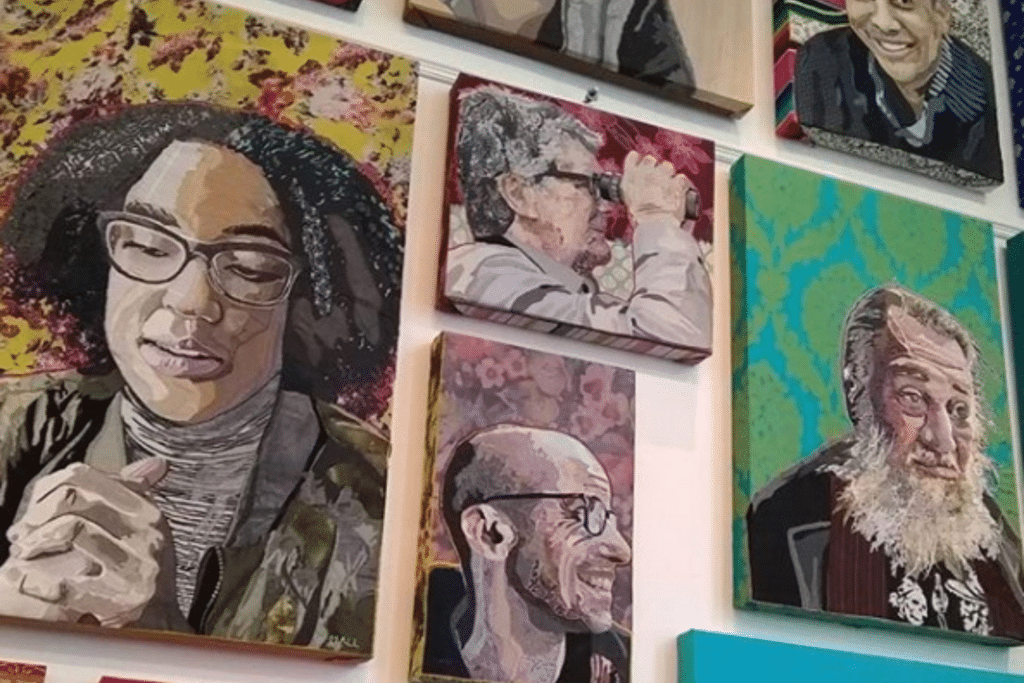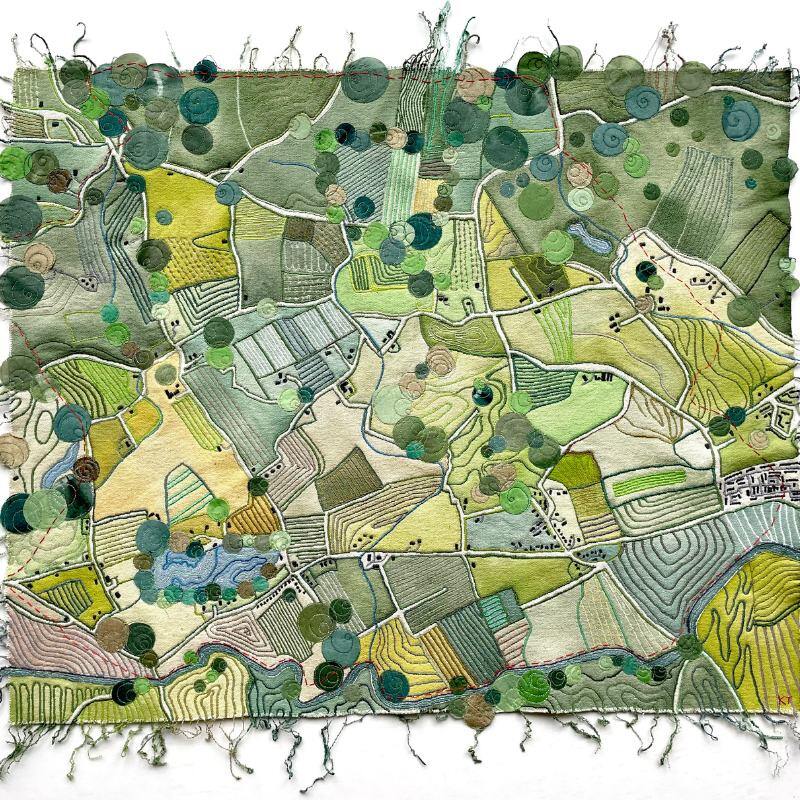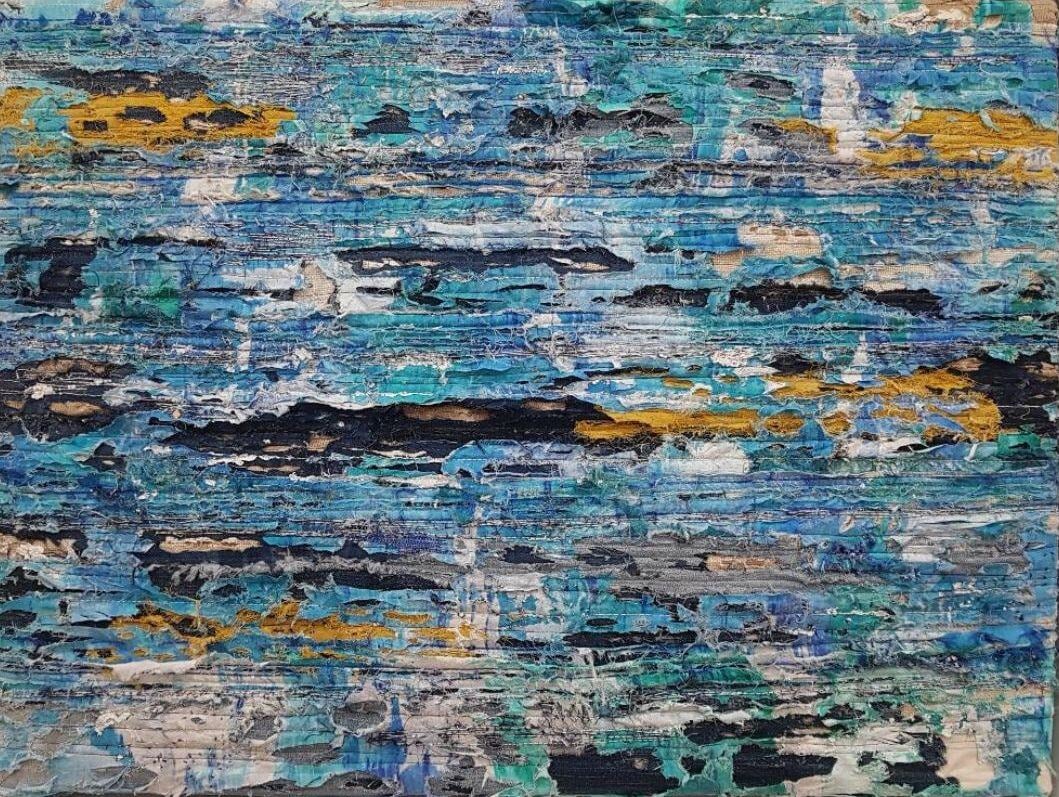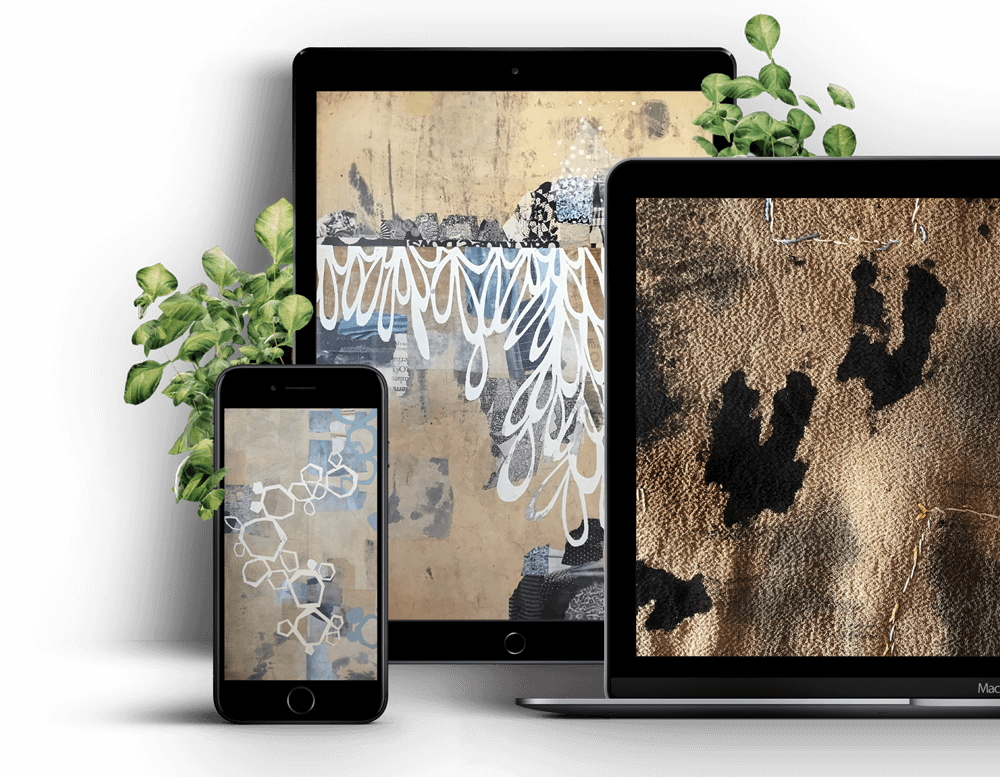Marian Jazmik
Marian Jazmik creates unique fibre art from her village in Northern England. She talked to Fibre Arts Take Two about her book, her art, and her process.
Marian’s Friday Feature Artist Interview can be found at the bottom of this page.
From a small village in northwest England, Marian Jazmik creates not for the sales commissions or notoriety but for the pure pleasure born out of her passion for textile art.
She spent 15 years teaching others art textiles, and now in her so-called retirement, Marian has grasped the opportunity to develop and produce her own work. Marian’s work evolves organically, akin to the fungi, lichen and moss she captures with her camera. She uses various heat treatments along with the inclusion of more unusual mixed media materials found in the home. These materials can include bath mats and scrubs, packaging wires, and all kinds of plastics.
Nothing is off-limits, as Marian enjoys the pure indulgence of experimental play. Following a successful solo exhibition at the knitting and stitching shows in 2019, Marian was approached to write about her creative journeys. Lockdown provided the ideal opportunity to put words on paper, and Textures From Nature in Textile Art was written and published in August 2021. Fibre Arts take Two sat down to talk with Marian about her book, art, and process.
Textures From Nature in Textile Art
Marian was one of the lucky few who was assisted by the lockdown.
“The lockdown came about four weeks after I was commissioned to write a book. I had the chance and the time to actually write the book. So it worked really well.”
Textures From Nature in Textile Art is a practical and inspirational guide to textile art. “Two-thirds of the book goes through my creative journeys, taking the reader from my inspirational photographs and how I got to the final piece. The first section talks about my primary inspiration, which is obviously the photographs. I then go on to explain how I use the various techniques. I tried to prompt with lots of what-if questions, so people could think it through and think, ‘Well, what if I did this on my work, or what if I develop my work this way?’”
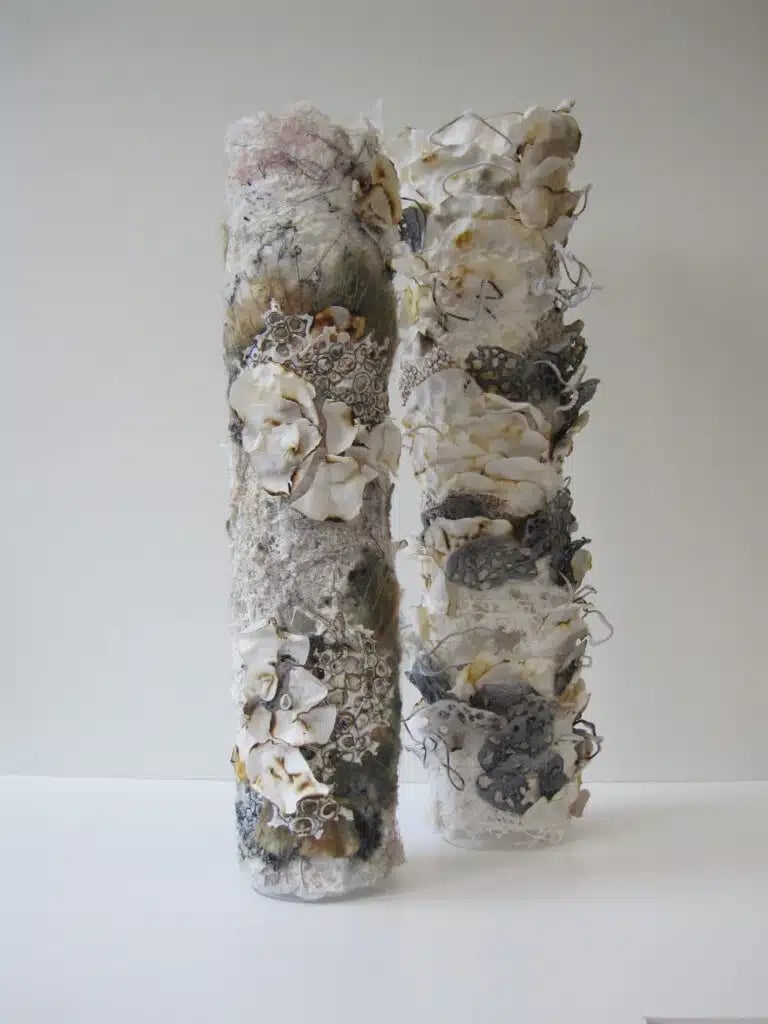
The need to stitch
Stitching is hard-wired in Marian’s DNA, “I have to stitch.” she says. ”I tend to stitch each day, even if it’s just 30 minutes or up to about two hours, usually in the early evening. During the day, my husband and I are out doing things, visiting places, going for walks, and going away for a few days. I have a workroom at home, so I can just go in there whenever I feel I can, just have a play, do little bits and bobs, as and when I feel like it.”
She certainly didn’t let lockdown or writing keep her from her passion, “Even though I was writing the book, I had to stitch. Some of the work I stitched during lockdown is in the book. I managed to get that in towards the end before it was completely finished.”
Positive feedback
Marian is an artist who creates art for herself first, “If I’m perfectly truthful”, she says, “I stitch because I enjoy stitching, and I enjoy the challenge and the problem-solving. I make for me, and if somebody else likes it, that’s a real bonus.”
Of course, many people love what Marian creates. Marian takes the praise with her charm and humility, “When I started to get positive feedback from people saying how much they liked the work, and then, especially at the exhibition, it was quite humbling and overwhelming. The response that I got from the exhibition was a really positive, confidence-boosting experience. It’s nice to know other people like what I’ve done.”
Breaking the rules
“I tend to use cold water dyes,” Marian told us when we asked about her process, “which don’t work on synthetic fabrics. I keep them in huge coffee jars, and I know you’re not meant to keep them for long, but I do. I don’t always follow the rules. I also use other colouring agents. Sometimes I’ve even used shoe polish to colour in some plastics.”
“I usually start off with a selection of fabrics,” Marian continues, “any fabric that I’ve got just laying around, and sort of immerse it into a cold water dye bath and then just leave all the fabric to dry scrunched up. The dye will run off, and that’s fine; that does leave some marks in the creases where the fabrics dry. But then, if you heat treat that fabric, the dye will concentrate and create quite exciting and unexpected results.”
In fact, the unexpected is essential to Marian’s process, “The way that I work, I don’t use a sketchbook. I can’t predict what the end product is going to be, so I never, I never use a sketchbook. My work literally evolves.”

The fabric or the form?
Marian incorporates photography into much of her work which begs the question; what comes first, the fabric or the form? Marian says both answers are true, “Sometimes I come across a fabric, and I may just play with that fabric by heat-treating it or dyeing it and then as a result of that little experiment, it may trigger an image of a photograph that I’ve taken, so then I may readdress that photograph, and the work may develop that way. Sometimes it’s the photograph, and then I start to search, think, and experiment with how I could interpret that photograph. Then I would look not just at one fabric, but I tend to combine lots of fabrics and then either dye them prior to combining them or I may then tear them apart and combine them with other fabrics.”
Everything you need
Marian loves to create beauty from the ordinary and the mundane, and she encourages aspiring artists to do the same. For example, she frequents scrap shops in her native England, “The scrap shop sells products from manufacturing that would otherwise go to the landfill, and I picked up a huge reel of monofilament fibre, which is like a fishing line. It’s just looking around and seeing what you’ve got in the home or what could work.”
All artists can also take inspiration from Marian’s fantastic, positive attitude. “If it doesn’t work, it doesn’t work, just put it to one side, and it’ll be suitable for something else.” It doesn’t get much more beautiful than that.
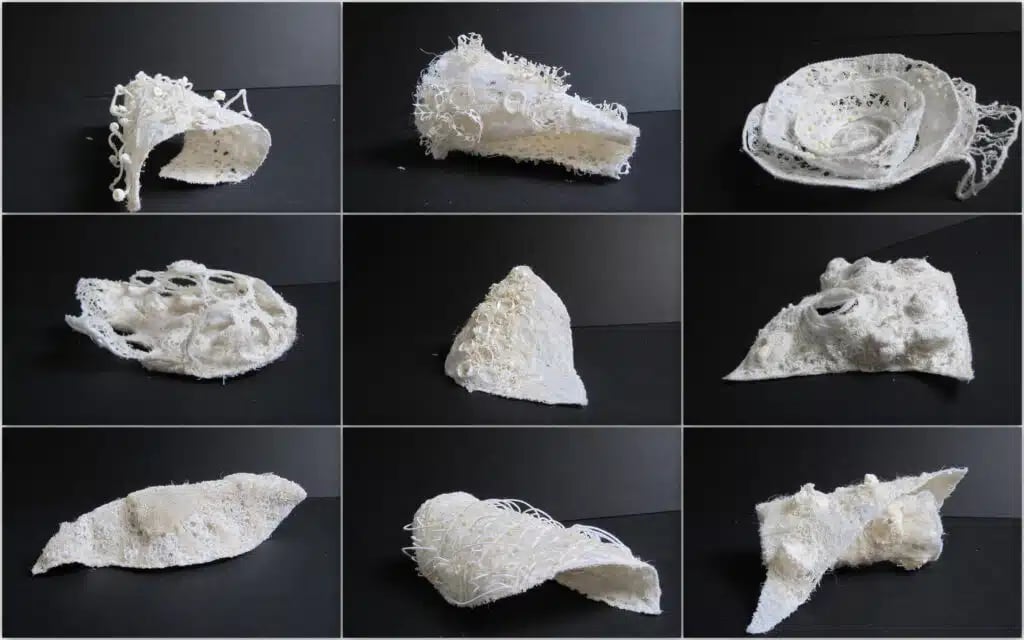
About the artist
Marian Jazmik lives in Egerton, Bolton, a small village in the North West of England on the edge of the Lancashire moors.
Combining her two favourite occupations, walking and embroidery, has resulted in the embroidered textile pieces that she produces. All her work is directly inspired by nature. For Marian, nothing is better for inspiration than the environment in which she lives, so armed with a camera, she can be found walking the country lanes, around the reservoirs and over the moors.
Since 2013 Marian has been producing mixed media pieces of textile work, wall art, 3D ‘vessels’ and sculptures. Her work is constantly developing and is becoming increasingly influenced by detailed textures of rocks, trees, foliage etc., observed whilst out and about.
Marian never goes anywhere without her camera and readily snaps away when she sees something that interests her, from the far-stretching view to the smallest area of texture seen upon a tree or rock. Her latest work has become more abstract in nature and is inspired by the various surface textures observed whilst walking, both in England and abroad.
Marian is also the author of the textile art guidebook Textures From Nature in Textile Art.
Notifications
Join Our Newsletter
OUR YOUTUBE CHANNEL
View our interviews and more on our Youtube channel!
OUR FACEBOOK GROUP
Join our Community and stay updated with our upcoming announcements!

